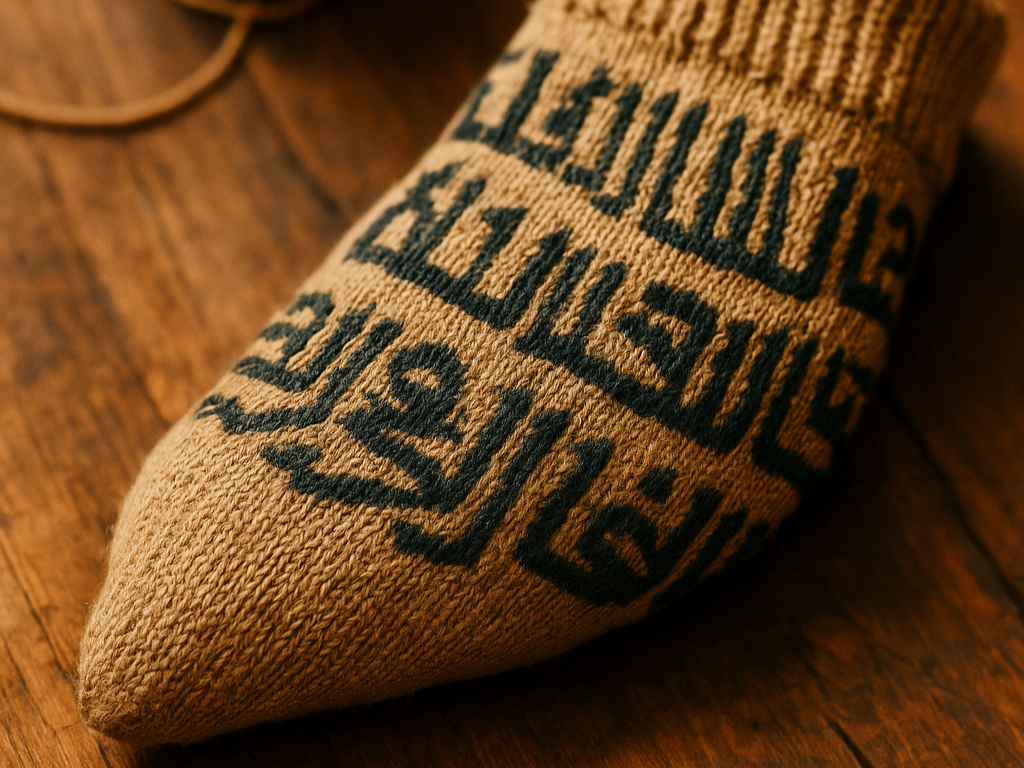#HistoryStitch: Ancient Socks with Arabic Protective Inscriptions

Sometimes textiles tell us more than chronicles: In Egypt, archaeologists found medieval knitted cotton socks, often blue-and-white, decorated with Kufic script – an early angular form of Arabic calligraphy. The inscriptions carried blessings and protective formulas, most likely intended as talismans against the evil eye. Finds are dated to the 11th–13th centuries CE, many from Fustat (old Cairo).
🏺 What Exactly Was Found?
Museums like the Metropolitan Museum of Art preserve complete socks from Fustat, knitted from cotton and dated to the 12th–13th centuries. Their construction is surprisingly modern, with a rounded foot and separate heel piece.
⚠️ Important distinction: the famous Coptic socks from the 4th–5th centuries (with split toes) were not knitted, but made in nålbinding. The true knitted examples appear much later, in the Islamic period.
🔤 How Were the Letters Knitted In?
Kufic script is ideal for two-color knitting: its rectangular, linear forms can easily be transferred into stitch grids. In several pieces, bands of script run around the ankle or instep, often repeating one word. Reconstructions mention inscriptions such as "baraka" (blessing), "Allah", or pseudo-Kufic (ornamental, non-readable letter forms).
Technique: round knitting in cotton, usually blue with natural/white, worked in stranded colorwork.
🧿 Why the Inscriptions? – Protection, Blessing, Status
In Islamic textile culture, inscriptions often carried baraka (blessing) and were connected to the tradition of tiraz textiles (inscribed fabrics, sometimes burial shrouds). On socks, the meaning was most likely apotropaic – offering protection with every step.
🧵 Construction Insights
-
Pattern bands: plain knitted sections alternate with lettered or geometric bands, always in prominent places like the instep or cuff.
Toe-up with separate heel: some socks were knitted from the toe upward, with the heel worked separately and sewn in – making it replaceable.
🧪 The Prehistory of Knitting
The Arabic-inscribed socks stand in contrast to earlier nålbinding socks from Late Antiquity. Distinguishing these techniques is crucial for understanding the true history of knitting.
🛠️ Practice Guide: Adding a Kufic Band to Modern Socks
A modern and respectful way to echo the historical tradition.
Choose your word/design
– Traditional: baraka ("blessing"), or neutral geometric pseudo-Kufic for a decorative approach.-
Create a stitch grid
– Swatch in the round with your yarn and needles.
– Translate letters into blocky motifs that fit the stitch grid. -
Plan the repeat
– Turn the word into a repeat (about 24–28 sts) and adjust to fit your sock's circumference. -
Color choice
– Historically blue/white. Modern variations: indigo/ecru, dark green/cream. -
Placement
– Best above the heel or across the instep, about 8–12 rounds tall. -
Technique
– Use stranded knitting, catch floats every 3–4 stitches. Cotton is authentic; wool-blend sock yarns are more durable.
💡 Tip: Start with a small swatch or initials in Kufic style before tackling a full band on socks.
🧶 Modern Pattern Idea
-
Top-down sock with 64–72 stitches.
-
Rib cuff → 8–12 rounds with script band → plain leg.
-
Reinforced heel + wedge toe.
-
Yarn: 4-ply sock wool or sportweight cotton.
🌟 My Conclusion
These so-called "magic socks" unite craft, belief, and daily life. They show how writing became wearable – as both ornament and talisman. And they remind us that knitting has been part of a global, connected textile history for nearly a thousand years.
Would you like to try a Kufic-inspired motif on your next pair of socks – historical in spirit, modern in design?
👉 Share your swatches and projects in my community with #knittingtrends!
#knittingtrends #madeinlove #historystitch #knittinghistory #textileheritage
Old stitches, sacred words, timeless steps – the Arabic socks show us how knitting carried both faith and fashion.
Warmly,
Kathrin ☀️🧶
Want to dive deeper into the world of stitches?
Explore my patterns, browse the blog, or join our community!
